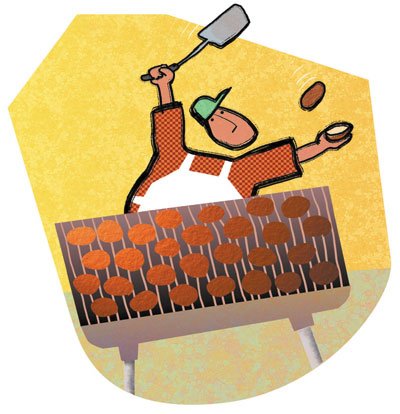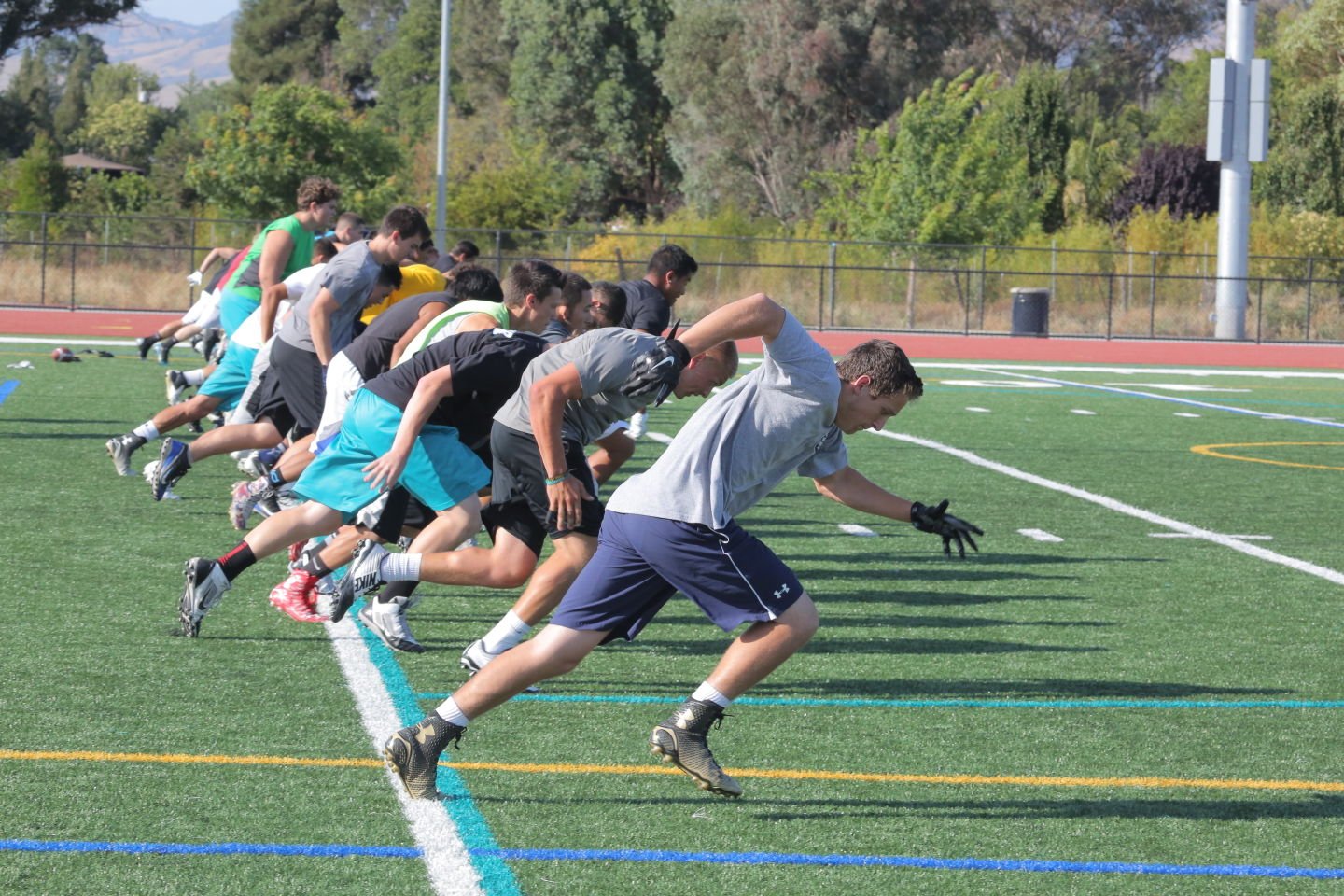Are barbecuing and grilling the same style of cooking?
Grilling is cooking directly over the heat source, flames or
coals, for short periods of time at high temperatures, up to 900
degrees in some commercial kitchens. Barbecuing is cooking with an
indirect heat source at temperatures in the 180- to 225-degree
range for hours.
Are barbecuing and grilling the same style of cooking?
Grilling is cooking directly over the heat source, flames or coals, for short periods of time at high temperatures, up to 900 degrees in some commercial kitchens. Barbecuing is cooking with an indirect heat source at temperatures in the 180- to 225-degree range for hours.
Which is better for grilling, charcoal or gas?
While 68 percent of Americans own gas grills, there are no hard facts that determine the better of the two. Gas grills deliver a slightly lighter flavor in the end product; unlike charcoal, gas contributes no taste. But gas grills offer push-button lighting and a constant and consistent heat source, and a propane tank can burn for as long as 20 hours. Charcoal grills are messier, the heat source is less predictable and they need to be restoked. But charcoal grills generally cook hotter, burning wood helps flavor food, and charcoal gives you “the primal thrill of lighting and playing with fire,” according to www.barbecuebible.com.
What kind of tools do I need when grilling?
– Long-handled tongs and spatulas grab, turn and flip food easily.
– Long-handled forks should only be used on larger food. Each time you pierce the food you lose flavorful juices.
– Grill baskets hold vegetables and smaller cuts of meat, while hinged fish baskets snap together tightly, holding the fish in place so it will not fall apart.
– A meat thermometer is essential for checking food’s internal temperature.
– Flame-retardant mitts and gloves, a basting brush and a wire brush for cleaning the grill are good additions.
Is it necessary to season a grill?
According to Gordon Grant, a manager at the Grapevine, Texas, Barbeques Galore, new grills, especially gas models, offer cooking grids that have surface coating and/or are made from heavy-duty stainless steel that require no seasoning. A few charcoal models still have cast-iron grids that have to be seasoned in order to create a natural, non-stick cooking surface and prevent rust. Some manufacturers recommend that you extend the preheating time 20 to 30 minutes, with the cover on, the first time any grilling unit is used to burn out residue or solvents that may have accumulated in the manufacturing and shipping process. This also tempers the unit.
How can I keep food from sticking to the grill?
– Clean the grill thoroughly after each use, according to the manufacturer’s instructions.
– Brush or spray the grill with vegetable oil prior to cooking.
– Preheat grills before using.
– Use a marinade or a light coating of vegetable oil on food before grilling.
– Be patient. Wait a few minutes after placing the food on the grill and let the heat sear the food before turning.
How does marinating help when I cook?
Marinades add flavor and tenderize. They can include vinegar, wine or citrus juice, olive oil, and herbs and spices. The acidic ingredients help soften the tissues of the meat. A few tips:
– The more tender the meat, the less time soaking in the marinade. Soak tender cuts two hours or less, tougher cuts for several hours or overnight.
– Always marinate meat in the refrigerator.
– Never use containers that will react to the acidic ingredients, such as metal bowls. Use glass or plastic bowls or plastic bags you can seal.
– Meat that has been marinated for a long period of time will take less time to cook. Twelve hours of marinating can reduce cooking time by 30 percent to 35 percent.
Can I use the marinade after I cook the meat?
The only way marinade can be reused is to boil it thoroughly to kill any bacteria transferred from the raw meat. Even then, it should only be used as a basting liquid or as sauce for the meat.
What about using dry rubs on the meat I grill?
These dry mixes of herbs and spices are rubbed into the raw meat to flavor the meat. The prepared meat is usually placed in a container in the refrigerator overnight before grilling.
Ingredients that can be used for a dry rub include black pepper, cumin, chili powder, crushed red pepper, celery seed, garlic powder or fresh crushed or minced garlic, salt, seasoned pepper and brown sugar. Use sugar sparingly as it melts and burns during cooking. Not only can burnt sugar provide unpleasant results in taste, it is very difficult to clean off the grill once it cools and hardens.
When should I flip a burger?
A 3/4-inch-thick burger should take eight to 10 minutes to cook, so be patient and wait for a few minutes before you flip. About halfway through the cooking time, juices will boil up through the burger to the surface. Take a look at the facedown side of the patty. If it is dark-brown … flip it!
How do you hand test a steak for doneness?
There are various hand tests that direct you to poke the steak and compare its firmness at various stages of doneness to that of your hand. In one, you make a tight fist and push down on the fleshy part between the index finger and thumb. This firmness indicates a steak that is probably well done. The firmness when you relax your grip about halfway indicates medium; total relaxation indicates rare. In another, you poke the fleshy part of the palm beside the thumb while holding the tips of your index finger and thumb together. The firmness here represents rare to medium-rare. As you touch each finger to the thumb in succession, working your way down to the pinky, the firmness will indicate medium, medium-well and well done. The only reliable way to test doneness is with a meat thermometer.
How do I know when food is fully cooked?
Using a meat thermometer to check internal temperatures will ensure you have cooked your food safely and to a certain level of doneness.
– Whole chicken, turkey: 180 degrees
– Chicken thighs and wings: 180 degrees
– Chicken breasts: 170 degrees
– Pork, well done: 170 degrees
– Pork, medium: 160 degrees
– Beef, well done: 170 degrees
– Beef, ground: 160+ degrees
– Beef, medium: 160 degrees
– Beef, medium rare: 145 degrees
– Beef, rare: 140 degrees
– Fish, turns from translucent to opaque: 145 degrees
Is there a cancer risk involved with grilling?
The grilling process generates two organic chemicals that do increase the risk of breast, colon, stomach and prostate cancer. When fat from food drips into the fire and burns, the smoke carries polycyclic aromatic hydrocarbons (PAHs) onto the food. Heterocyclik amines (HCAs) can also form on meat, poultry or fish when grilled. You can lower the risk by precooking meats and shortening the cooking time on the grill, cooking low-fat meats and trimming off as much fat as possible, not letting flames touch and char the meat, and cutting off charred portions before serving.
What are the occasions when most people
fire up the grill?
A survey sponsored by grill manufacturer Weber-Stephen found that the most popular grilling occasions (in order of popularity) are Independence Day, Labor Day, Memorial Day, birthdays, Father’s Day, Mother’s Day, Thanksgiving Day, graduations and Christmas.
What is the largest
cookout on record?
The Guinness world record for largest barbecue was a one-day event attended by 44,158 people at a racecourse in Sydney, Australia, in 1993. What went on the grill? More than 300,000 sausages, 100,000 steaks and 50,000 chicken burgers.
What are some tips for safe grilling?
The Hearth, Patio & Barbecue Association lists nearly three pages of safety tips for outdoor grilling at www. hpba.org/consumer/bbq/safety.shtml.
A few of them are:
– Barbecue grills are designed for outdoor use only. Never barbecue in your trailer, tent, house, garage or any enclosed area.
– Use long-handled barbecue utensils to avoid burns and splatters.
– Never use gasoline or kerosene or other highly volatile fluids as a starter. They can explode.













